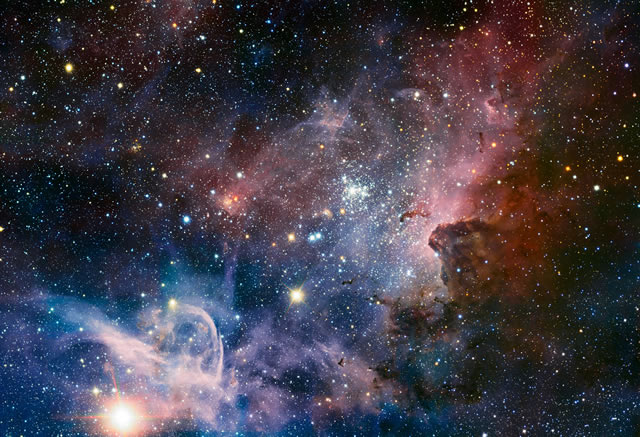
Il VLT (Very Large Telescope) dell’ESO ha prodotto la più dettagliata immagine del vivaio stellare noto come Nebulosa Carena mai ottenuta nella banda infrarossa. Molte strutture prima nascoste sono state svelate su questo sfondo celeste spettacolare di gas giovani stelle e polvere. Questa è una delle più spettacolari immagini mai create dal VLT.
Nel cuore della zona australe della Via Lattea si trova un vivaio stellare che va sotto il nome di Nebulosa Carena. Si trova a circa 7500 anni luce dalla Terra nella costellazione della Carena. Questa nube di gas incandescente e di polvere è una delle più vicine incubatrici di stelle massicce e contiene molte delle più grandi e brillanti stelle note. Una di queste, la misteriosa e instabile Eta Carinae, fu la seconda stella più luminosa nel cielo per parecchi anni nel decennio del 1840 e probabilmente esploderà come supernova in un futuro non lontano, su scale astronomiche ovviamente. La Nebulosa Carena è un laboratorio ideale per gli astronomi che vogliono studiare la nascita violenta e l’infanzia delle stelle.
Anche se questa nebulosa risulta spettacolare in luce visibile (eso0905), molti dei suoi segreti si nascondono dietro spessi veli di polvere. Per penetrarli, un gruppo di astronomi europei, guidato da Thomas Preibisch (University Observatory, Munich, Germania) ha utilizzato le capacità del VLT (Very Large Telescope) dell’ESO in combinazione con una camera sensibile all’infrarosso chiamata HAWK-I.
Centinaia di singole immagini sono state combinate per creare questa foto finale, il mosaico infrarosso della nebulosa più dettagliato che sia mai stato realizzato e una delle più spettacolari immagini mai create dal VLT. Mostra non solo le stelle massicce più luminose, ma anche centinaia di migliaia di stelle più deboli che prima non erano visibili.
La stessa abbagliante Eta Carinae appare in basso a sinistra in questa nuova immagine, circondata da nubi di gas che risplendono, incandescenti, sotto il feroce assalto della radiazione ultravioletta. In tutta l’immagine ci sono anche zone scure di materiale denso e compatto che rimane opaco anche nella banda infrarossa: sono i gusci di polvere che avvolgono le nuove stelle in formazione.
Nel corso degli ultimi milioni di anni, in questa regione celeste si sono formate molte nuove stelle, sia singole che in ammasso. L’ammasso brillante vicino al centro dell’immagine è Trumpler 14. Anche se compare nelle immagini nella banda visibile, un numero molto maggiore di stelle più deboli è evidente in questa vista all’infrarosso. Sulla sinistra invece si nota una piccola concentrazione di stelle che appare di color giallo. Questo raggruppamento di stelle è stato visto per la prima volta in questi nuovi dati del VLT: queste stelle non sono per nulla visibili nella banda della luce visibile. Questo è solo uno dei tanti nuovi oggetti appena svelati in questo panorama spettracolare.
VLT Takes Most Detailed Infrared Image of the Carina Nebula
ESO’s Very Large Telescope has delivered the most detailed infrared image of the Carina Nebula stellar nursery taken so far. Many previously hidden features, scattered across a spectacular celestial landscape of gas, dust and young stars, have emerged. This is one of the most dramatic images ever created by the VLT.
Deep in the heart of the southern Milky Way lies a stellar nursery called the Carina Nebula. It is about 7500 light-years from Earth in the constellation of Carina (The Keel). This cloud of glowing gas and dust is one of the closest incubators of very massive stars to the Earth and includes several of the brightest and heaviest stars known. One of them, the mysterious and highly unstable star Eta Carinae, was the second brightest star in the entire night sky for several years in the 1840s and is likely to explode as a supernova in the near future, by astronomical standards. The Carina Nebula is a perfect laboratory for astronomers studying the violent births and early lives of stars.
Although this nebula is spectacular in normal visible-light pictures (eso0905), many of its secrets are hidden behind thick clouds of dust. To penetrate this veil a European team of astronomers, led by Thomas Preibisch (University Observatory, Munich, Germany) has used the power of ESO’s Very Large Telescope along with an infrared-sensitive camera called HAWK-I.
Hundreds of individual images have been combined to create this picture, which is the most detailed infrared mosaic of the nebula ever taken and one of the most dramatic images ever created by the VLT. It shows not just the brilliant massive stars, but hundreds of thousands of much fainter stars that were previously invisible.
The dazzling star Eta Carinae itself appears at the lower left of the new picture. It is surrounded by clouds of gas that are glowing under the onslaught of fierce ultraviolet radiation. Across the image there are also many compact blobs of dark material that remain opaque even in the infrared. These are the dusty cocoons in which new stars are forming.
Over the last few million years this region of the sky has formed large numbers of stars both individually and in clusters. The bright star cluster close to the centre of the picture is called Trumpler 14. Although this object is seen well in visible light, many more fainter stars can be seen in this infrared view. And towards the left side of the image a small concentration of stars that appear yellow can be seen. This grouping was seen for the first time in this new data from the VLT: these stars cannot be seen in visible light at all. This is just one of many new objects revealed for the first time in this spectacular panorama.

















